The other week I had an onslaught of mother runners randomly asking me on Instagram how they could stop leaking while running. I realized this is a common problem among mother runners that need to be practically addressed. Research shows that one in three women leak during exercise postpartum. Another study found that almost half of elite endurance athletes experience leakage while running. That’s a lot of leakages.
But, there’s no need to resign ourselves to wearing dark leggings and shorts and running in our own filth for the rest of our lives. This is a problem that can actually be fixed at home, says physical therapist and pelvic floor specialist Dr. Carrie Pagliano.

Myths about our pelvic floor
First thing’s first, Carrie wants to dispel a few myths out there about leaking while running.
- Leaking while running does not mean you have a weak pelvic floor.
- If you do have a weak pelvic floor, it is not dangerous. It does not mean you are destined for pelvic organ prolapse. The contributing factors to that are much more complicated.
- Kegels (tightening of the pelvic floor muscles) are not always the answer or ever enough.
Related: How Pros Return to Running Postpartum
Anatomy of the pelvic floor
To understand these misconceptions, we need to first understand how our body is made. Your pelvic floor muscles are like a hammock for your bladder and uterus that run from your pubic bone, through your rectum, to your tailbone, and between your hip bones. For mother runners, that trampoline can get stretched and affected by carrying a baby around for 9 months.
Sometimes the muscles are weakened by the load of pregnancy. Other times, our pelvic floor muscles are too overactive, clenching all the time, and eventually, giving way for a deluge. In some cases, the tissue is laxer due to changing hormone levels (this is impacted by pregnancy and breastfeeding) and genetics which impacts collagen and ligament laxity levels. Finally, the bigger opening—ahem–down there (levator hiatus) after childbirth can play a role.
Common causes of leaking while running:
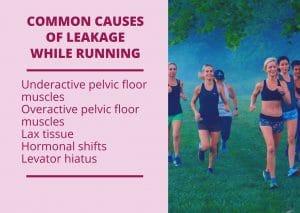
- Underactive pelvic floor muscles
- Overactive pelvic floor muscles
- Lax tissue
- Hormonal shifts
- Levator hiatus
Simply doing Kegels (contracting and relaxing your pelvic floor muscles) won’t address these issues and for those who have overactive muscles, it will actually make the issue worse.
Related: 8 clever tips to run while breastfeeding
How to find out why you’re leaking while running
So how can you find out WHY you’re leaking while running? Carrie shares tests you can do at home to screen yourself–no doctor’s or physical therapist’s office visit required. (However, it is important to note that the cause may not be easily detectable and you may need to see a pelvic floor physical therapist.)
First, get a baseline to find out if you have any issues at all.
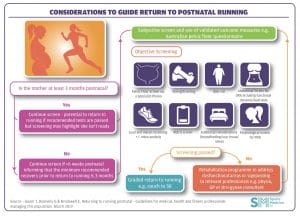
To find out if you have any pelvic floor issues:
Try to do a pogo jump (jumping high on both feet in place) for one minute. If you leaked, there is a good chance your floor needs some attention–either coordination for overactive pelvic floor muscles or strengthening for underactive pelvic floor muscles.
Related: Postpartum Running Plan
To find out if your pelvic floor is underactive:
Squeeze your pelvic floor muscles (like you’re stopping yourself from peeing, aka a Kegel) and try to hold it for 10 seconds while maintaining your breath. If you cannot hold it for very long (and breathe at the same time), then there is a good chance your muscles are underactive. If you can’t hold it very long or the squeeze is weak, it’s likely to be underactive.
To find out if your pelvic floor is overactive:
Does it hurt to insert a tampon or have sex? If you answered yes, those are signs your pelvic floor muscles are too tense. Another way to find out is to insert two fingers inside your vaginal opening and squeeze your muscles like you are holding in gas (closing the anus, pulling in that turtlehead…). You will feel the muscles close in around your fingers and lift them inside. Then release. If you don’t feel the muscles retract, then your pelvic floor muscles are overactive. You can also try a Kegel and if you don’t feel much difference between contraction/relaxation there’s a strong possibility your muscles might be overactive.
What to do if you aren’t sure you’re using your pelvic floor muscles
Gráinne Donnelly, UK-based physiotherapist and co-author of the “Returning to Running Postnatal” guidance, highlights that there are a variety of physical cues to assist people in their awareness of engaging the pelvic floor. Thus, you may need to experiment with different exercises to figure out what works best for you.
“Different cues for pelvic floor recruitment work better for different people. It can be good practice to try a few and decide which results in better awareness of pelvic floor recruitment,” she explains.
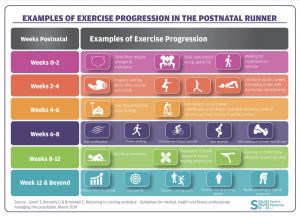
Cues to try at home include:
- Imagine a zipper from back passage to front passage, imagine closing that zips up and opening it again
- Imagine you are holding in gas
- Imagine you are stopping yourself from peeing
- Imagine you are closing the anus, pulling in that “turtlehead”
Gráinne advises if you cannot feel anything or are unsure whether your pelvic floor muscles are overactive and tight, seeing a physical therapist specializing in pelvic health can help.
How to fix your pelvic floor issues
Strengthening or coordinating (ensuring your muscles are tensing at the right times) your pelvic floor involves more than just Kegels. Our muscles work in concert with one another so it’s important to strengthen or coordinate the entire surrounding area including our hips and core.
Related: How to start running after baby
Pelvic floor strength routine for runners postpartum:
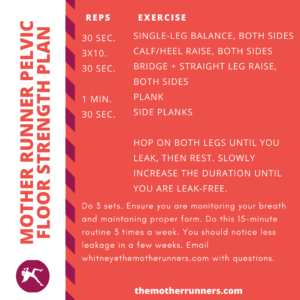
Here is a good pelvic floor strength routine for mother runners postpartum at any stage, e.g. women with underactive pelvic floor muscles.
- Single-Leg Balance up to 30 seconds each side
- Calf/Heel Raise, up to 3 sets of 10
- Bridge + Straight Leg Raise up to 30 seconds each side
- Plank up to 1 minute
- Side Plank up to 3o seconds each side
- Hop on both legs until you leak, then rest. Slowly increase the duration until you are leak-free.
Ensure you are maintaining good form. If your technique suffers from fatigue, stop and work up to the set amounts. Also, be sure to monitor your breath. Exhalation before AND during effort can help activate the deep abs and pelvic floor to provide support.
Do this 15-minute routine 3 times a week. You should notice less leakage in a few weeks. Dr. Pagliano notes dry running is the last to come–and combining strength, balance, and agility drills will make it arrive faster. Also, running with shorter strides and a quieter footfall can reduce the risk of leakage due to decreased impact.
Related: Speed drills that make you run faster
Pelvic floor muscles coordination routine for runners with overactive pelvic floor muscles:
If your pelvic floor muscles are overactive, try low belly breaths. Here is how you do it:
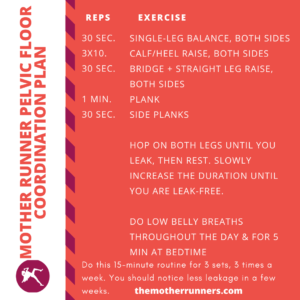
Low belly breathing tips
- Do 5-minutes of low belly breaths that expand your ribs like a pufferfish to relax the muscles at bedtime and then a breath throughout the day.
- Pay attention to your breath throughout the day.
- Make sure you aren’t holding your breath or breathing in your upper chest/holding tension when you don’t need to be. These activities increase the pressure downward and make the brain want to counter that pressure with activity from the pelvic floor muscles (hence the overactive muscles).
Sometimes symptoms change with breathing alone because you’re making the pelvic floor muscles more available. However, you may also need to train your breathing through dynamic hopping (like a pogo jump, and hopping on one leg) as well as working to strengthen your core and hips through the above exercises mentioned for underactive pelvic floor muscles.
Addressing other causes of leaking while running
As noted, there are other causes for leakage while running not related to the activity of your pelvic floor muscles. If you suspect that may be the case for you, these are potential solutions.
- If hormone levels are the culprit, a topical estrogen or estrogen/testosterone cream (when you’re done breastfeeding and you do not have a family history of breast cancer) may help.
- Also, for hormonal causes of leakage, new birth control can make a difference if you notice your symptoms correlate with a particular point in your cycle.
- If a larger vaginal opening is the cause for leakage while running, a well-fit pessary support can be helpful.
- If you have lax tissue, incorporating the above strength routine can help.
Related: After-baby run-to-walk plan
Most runners, especially time-poor mother runners, don’t like taking the time to strength train. But these exercises will not only liberate you from dark running attire and keep you dry, but they will also save you from injury and improve your overall running efficiency.
Do you know what that means? More miles. More fun. No dark running shorts required.
Other resources:
There is a recently published paper in the British Journal of Sports Medicine by a multidisciplinary team, including Gráinne, that guides health and fitness pros in how to assist women with their return to running after childbirth. There is a small fee to download.
Gráinne and two other researchers of the BJSM article, Emma Brockwell and Tom Goom, have a free downloadable guidance book for everyone from health and fitness pros to women themselves to increase their understanding of the physical and emotional changes that come about with pregnancy and delivery. You can download a copy from here https://mailchi.mp/
Download the considerations to guide return to postnatal running image here but you may not reuse without permission: Considerations to guide return to postnatal running.
Download the exercise for the postnatal runner image but you may not reuse without permission: exercise in the postnatal runner.
PS-I’d love to help you reach your running goals whether it be to run your first 5k or run competitively! Email me at [email protected] with questions or check out my Coaching Services page!
⠀⠀⠀⠀⠀⠀⠀⠀⠀
⠀⠀⠀
⠀⠀⠀⠀⠀⠀⠀⠀
